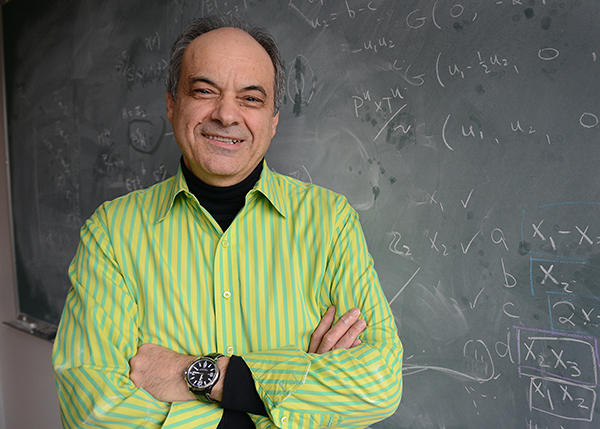Wednesday, Nov 4, 2015
Rider professor Tony Bahri collaborates with some of the world’s best mathematicians
by Adam Grybowski
This spring, Rider University mathematics professor Tony Bahri worked alongside some of the finest mathematical minds in the world as a Visiting Research Scholar at Princeton University.
“It was a great privilege and exhilarating to be visiting a department in which there is so much activity,” Bahri says. “The intense mathematical environment was a little like Disneyland for me.”
Bahri’s research focuses on toric topology, a relatively new field that uses algebra and combinatorics to analyze complex shapes. Topologists study the often counter-intuitive way that shapes in multiple dimensions can be formed and deformed. The seemingly abstract field has large implications for some of the most important questions occupying the minds of scientists and mathematicians today. For example, it is topology that helps string theorists speculate on the shape of the universe, which scientists believe exists in as many as 10 dimensions.
During Bahri’s appointment, which did not include teaching responsibilities, he had one paper accepted, with another submitted for review and two more in preparation. The experience also reinvigorated Bahri as he returned to his teaching responsibilities at Rider. “I love teaching and have enjoyed the transition back to Rider,” he says. “Our department was very welcoming and I’m even happier in my usual life than I was before I left.”
In March, Bahri co-organized an international conference in geometry and topology that was held in Princeton. The event gave graduate students a chance to mingle with many experts from all over the world — a heartening achievement for Bahri. “The conference provided excellent talks by distinguished speakers, but it was the young people who injected the energy that really made it successful,” he says.
During Bahri’s time at Princeton, where he continues as a co-organizer of a weekly algebraic topology seminar, he also traveled abroad, lecturing in Moscow and Italy, but it was the time spent at the blackboard, working on mathematical conundrums with his collaborators and colleagues, that he particularly relished. “When you are collaborating with good friends, the doing of mathematics is a way of expressing the friendship,” he says. “The blackboard is central. You can only go so far communicating through email. Standing around it and arguing mathematics is an intense human activity, but it’s also intimate, like being with your friends while having dinner or taking a walk.”
At Princeton, Bahri worked next door to mathematician and Nobel Economics Prize winner John Nash, who received public prominence after a movie starring Russell Crowe, A Beautiful Mind, was released. Working so close in proximity, the two struck up a friendship, and Nash requested that Bahri be invited to speak at the Princeton MIT Club in April. The event was intended as a celebration of Nash receiving the Abel Prize, but after he and his wife were killed in a car accident in March, the event became a tribute. “I was very honored to be asked to do it,” Bahri says.
Bahri’s other lectures included appearances at the Princeton Chapter of the Association of Computing Machinery/Institute of Electrical and Electronic Engineers, Rutgers University and Vassar College. Once his time at Princeton wrapped up in June, Bahri joined Cape Breton University in July as a Visiting Scholar. This fall, he was invited to lecture in Mexico and China. How does Bahri account for the demand for his appearances throughout the world?
“My collaborators and I have been fortunate to have our work attract attention. Moreover, I do more undergraduate teaching than many of my research colleagues,” he says. “I’m accustomed to explaining things in a way that avoids making excessive demands on audiences. I have learned to do that through my teaching. Generally, people appreciate that, sometimes experts do too.”

